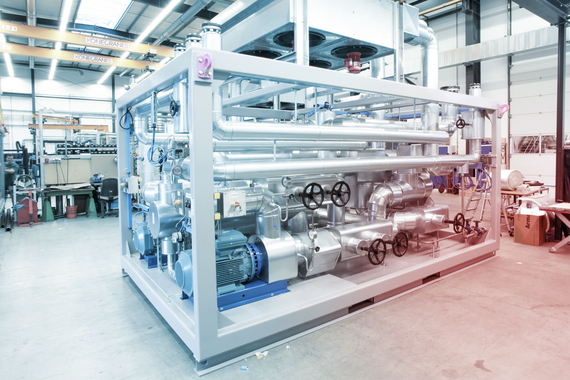The Duty of Heat Transfer Systems in Sustainable Power Solutions for the Future
Heat transfer systems are vital in the pursuit for sustainable energy remedies. They maximize thermal power management, boosting the performance of renewable technologies. By using devices like conduction, convection, and radiation, these systems reduce energy losses. Their duty in solar thermal and geothermal applications is especially considerable. As advancements emerge, the possibility for additional advancements elevates vital concerns concerning future energy methods. What growths will form the landscape of lasting power?
Understanding Heat Transfer Systems

The Importance of Thermal Power Management
Effective thermal power administration is crucial for taking full advantage of energy efficiency and minimizing waste in numerous systems. By controling temperature level and enhancing Heat transfer processes, companies can considerably reduce power consumption and operational expenses. Efficient monitoring involves the execution of innovative technologies and practices that keep track of and regulate thermal conditions within systems, guaranteeing that energy sources are made use of efficiently. Additionally, appropriate thermal energy administration adds to minimizing greenhouse gas discharges, straightening with global sustainability objectives. It additionally improves system dependability and performance, leading to enhanced item high quality and longer devices life-span. Eventually, focusing on thermal power administration is a vital step in the direction of developing much more lasting energy options and promoting a liable approach to energy consumption in property and industrial contexts.
Applications of Heat Transfer in Renewable Power
While various renewable resource resources assure sustainability, the effective application of Heat transfer plays a crucial function in their effectiveness. In wind power systems, Heat transfer is utilized for wind turbine element air conditioning, enhancing efficiency and longevity. Geothermal energy depends on reliable Heat exchange between the planet's subsurface and the liquid circulating in the system, making best use of energy extraction. Biomass power processes likewise profit from Heat transfer, as it helps in converting natural products right into usable fuel via pyrolysis and gasification. Additionally, in hydropower, maintaining perfect temperatures in tanks can enhance energy outcome. Each of these applications demonstrates the essential value of Heat transfer systems in enhancing renewable resource modern technologies, inevitably contributing to a more lasting energy future.
Enhancing Solar Thermal Power Performance
As solar thermal power systems continue to progress, boosting their effectiveness has come to be important for taking full advantage of energy output. Advances in Heat transfer modern technologies, such as boosted thermal storage space products and ingenious Heat exchangers, play a significant duty in enhancing efficiency. By using advanced materials that have superior thermal conductivity, systems can transfer and catch Heat extra properly. Furthermore, incorporating radar that comply with the sunlight's path assurances that collectors get suitable solar direct exposure throughout the day. Utilizing nanotechnology in solar absorbers can better enhance power absorption rates. Furthermore, incorporating automated control systems aids regulate temperatures and handle energy circulation effectively, resulting in minimized losses and boosted total system performance. These improvements lead the means for more lasting solar thermal power remedies in the future.
Geothermal Home Heating: A Lasting Option
Geothermal heating presents a practical option for sustainable energy, supplying substantial ecological benefits via decreased greenhouse gas emissions. Its effectiveness and cost-effectiveness make it an appealing option to typical home heating systems. Challenges connected to application needs to be resolved to maximize its prospective effect.
Ecological Advantages of Geothermal
Conventional heating methods contribute significantly to greenhouse gas emissions, geothermal home heating offers a compelling option that minimizes environmental influence. By taking advantage of the Planet's internal Heat, geothermal systems utilize a sustainable power source, markedly minimizing dependence on fossil fuels. This approach creates minimal carbon discharges, making it a cleaner alternative for industrial and residential heating. In addition, geothermal systems advertise power efficiency, as they require much less power contrasted to conventional heating unit. DVS Heat Transfer Systems. The usage of geothermal power also assists in decreasing air pollution, boosting neighborhood air high quality and public health. As a lasting option, geothermal home heating sustains environment change mitigation efforts, placing itself as an essential component in the shift towards a greener future
Effectiveness and Cost-Effectiveness
Just how does geothermal home heating determine up in regards to effectiveness and cost-effectiveness compared to standard heating systems? Geothermal home heating demonstrates exceptional effectiveness, commonly accomplishing a coefficient of efficiency (POLICE) of 3 to 5, implying it creates three to five devices of Heat for every single unit of electrical power consumed. This performance equates into reduced operating expense, particularly in regions with stable geothermal sources. Preliminary setup costs can be higher than conventional systems; however, long-term cost savings on energy costs and lowered maintenance expenditures can balance out these upfront financial investments. In addition, numerous governments incentivize geothermal systems with rebates discover this and tax credit scores, improving their cost-effectiveness. Overall, geothermal home heating becomes a sustainable and economically feasible choice to even more conventional heating solutions.
Application Difficulties and Solutions
Countless obstacles can impede the widespread implementation of geothermal home heating systems, in spite of their clear advantages as a sustainable power solution. High initial installment costs usually prevent investors and home owners, making funding a significant barrier. In addition, the geographical limitations of appropriate geothermal websites restrict availability in certain regions. Neighborhood policies and permitting processes can also make complex task advancement, leading to delays. Moreover, public recognition and understanding of geothermal systems continue to be reduced, hindering acceptance. To resolve these challenges, targeted education campaigns can improve open secret, while federal government incentives could alleviate financial concerns. Working together with neighborhood authorities to simplify regulations may help with smoother job authorizations, inevitably advertising the fostering of geothermal home heating as a sensible, sustainable power option.
Innovations in Heat Transfer Technologies
Advancements in Heat transfer innovations play an important function in improving energy efficiency and sustainability. Advanced Heat exchangers and stage adjustment products go to the leading edge of these advancements, providing substantial enhancements in thermal monitoring. These innovations not just enhance power usage yet additionally contribute to lowering environmental influence in various applications.
Advanced Heat Exchangers
Advanced Heat exchangers play an important duty in improving power effectiveness across different applications in lasting power remedies. These tools facilitate the transfer of Heat in between two or more liquids, significantly minimizing power consumption in processes such as industrial home heating, air conditioning, and power generation. Advancements in materials and layout, such as making use of nanofluids and compact arrangements, have led to improved thermal efficiency and reduced dimension demands. In addition, innovations in digital monitoring and control systems permit for optimized procedure, further enhancing performance. By reducing waste Heat and maximizing power healing, advanced Heat exchangers add to lower carbon footprints and sustain the change towards advice eco-friendly technologies. Their continued advancement is vital for accomplishing international energy sustainability objectives.
Stage Modification Products
The integration of phase adjustment materials (PCMs) right into Heat transfer modern technologies stands for a substantial advancement in energy management and efficiency. PCMs absorb and release thermal power throughout their stage changes, enabling effective temperature level regulation in building products and power systems. By saving excess Heat during top periods and releasing it when demand rises, PCMs add to load shifting and energy conservation - DVS Heat Transfer Systems. This ability improves the efficiency of renewable energy systems, particularly in solar thermal applications. Additionally, PCMs can enhance the thermal comfort of indoor atmospheres, lowering dependence on standard home heating and cooling down approaches. As technologies in PCM formulas continue to emerge, their role in sustainable energy solutions is positioned to grow, using appealing opportunities for future study and application

Future Potential Customers for Heat Transfer in Sustainable Energy
As the need for sustainable power solutions continues to increase, the duty of Heat transfer systems is becoming significantly important fit future technologies. Developments in products and designs are anticipated to enhance efficiency in Heat transfer, reducing energy losses in numerous applications. The combination of innovative thermal storage systems, such as stage change materials and thermochemical storage, will certainly make it possible for far better administration of energy sources. Research into nanofluids and biomimetic Heat exchangers may additionally enhance thermal efficiency. In addition, the adoption of smart innovations will enable real-time tracking and adaptive control of Heat transfer processes. These improvements are poised to considerably add to the general efficiency and sustainability of energy systems, leading the way for a much more energy-efficient future.
Often Asked Concerns
How Can People Apply Heat Transfer Solution in your home?

Individuals can implement Heat transfer systems at home by installing energy-efficient home appliances, utilizing radiant heat, and optimizing insulation. These steps improve power performance, minimize prices, and promote sustainable practices in domestic atmospheres.

What Are the Prices Connected With Mounting Heat Transfer Systems?
The expenses linked with mounting Heat transfer systems differ extensively, normally including devices, installation labor, and upkeep. Aspects such as system kind, home size, and neighborhood policies considerably affect the total expense involved.
Are There Government Rewards for Heat Transfer System Installations?
Government motivations for Heat transfer system installations vary by area and can consist of tax obligation rebates, gives, and credit scores. These monetary advantages intend to urge adoption, eventually promoting energy efficiency and reducing ecological impact within communities.
How Do Heat Transfer Solutions Influence Energy Costs?
Heat transfer systems notably affect energy costs by enhancing energy performance. By improving the transfer of Heat, these systems minimize power consumption, causing lower utility costs and creating a more sustainable strategy to energy monitoring.
What Maintenance Is Needed for Heat Transfer Systems?
Upkeep for Heat transfer systems consists of routine inspections, cleansing of elements, examining liquid degrees, guaranteeing proper insulation, and changing used components. These jobs assist keep effectiveness, avoid breakdowns, and lengthen the system's functional life-span.
These systems promote the motion of thermal energy from one tool to one more, making it possible for the transfer of Heat for energy, air conditioning, or heating generation objectives. Geothermal power counts on effective Heat exchange between the earth's subsurface and the liquid distributing in the system, optimizing energy removal. In addition, geothermal systems see this promote power efficiency, as they require much less energy compared to traditional heating systems. Advanced Heat exchangers play an essential role in improving energy performance across various applications in lasting energy options. Heat transfer systems significantly affect energy costs by enhancing energy efficiency.